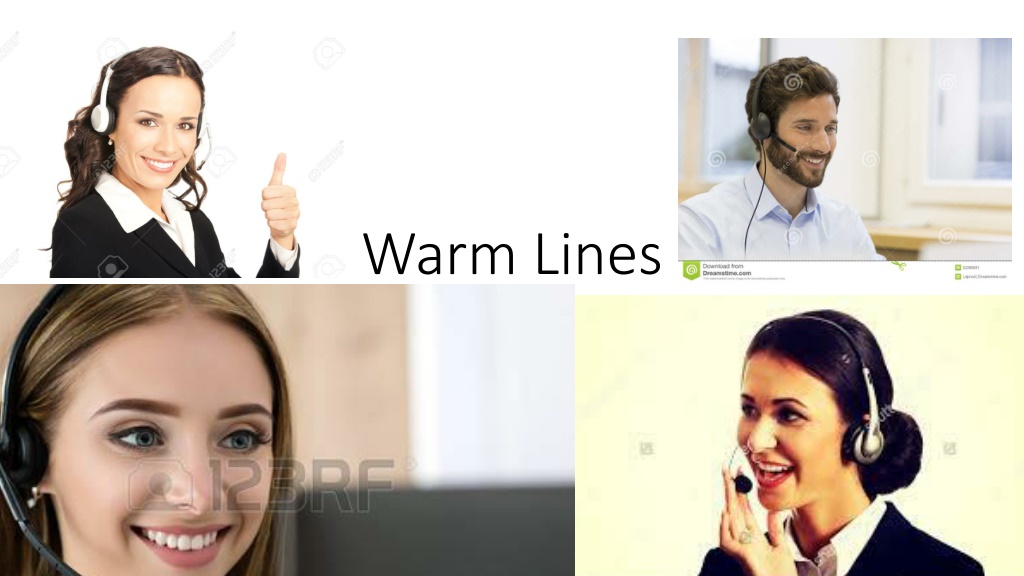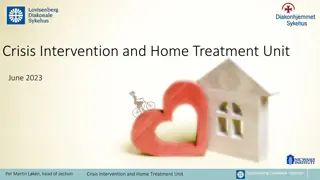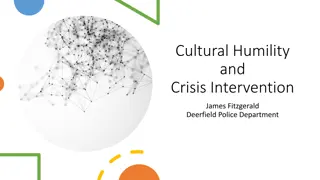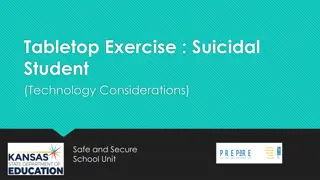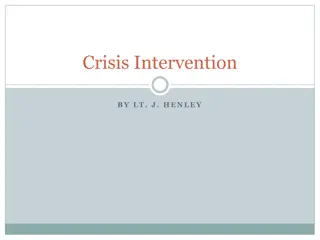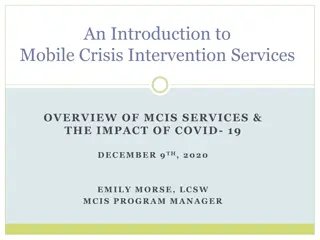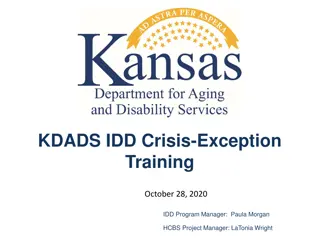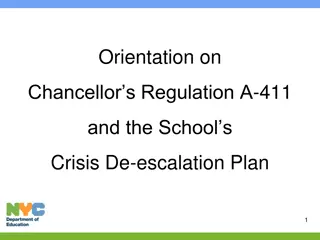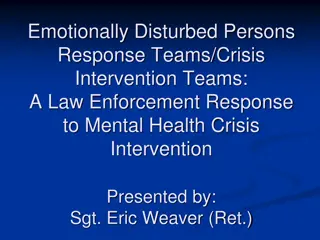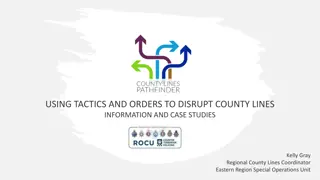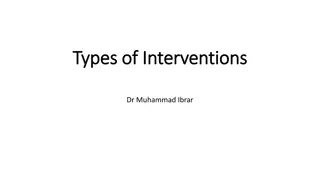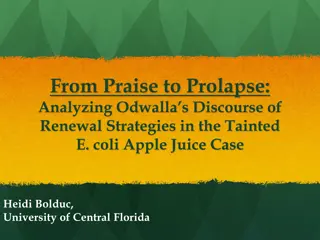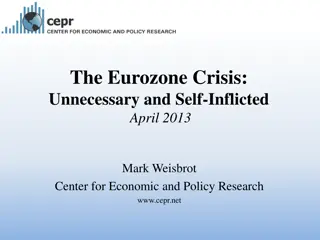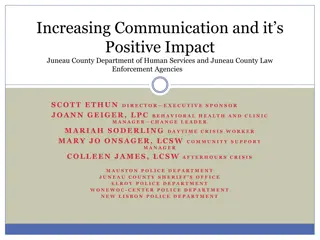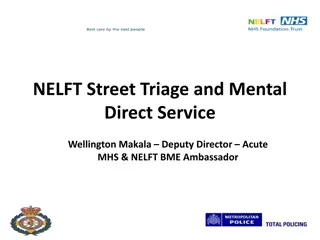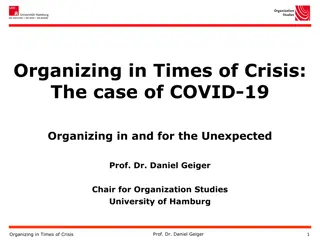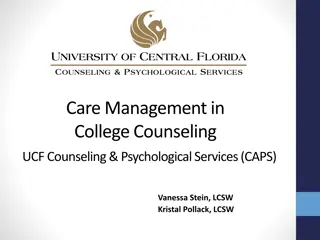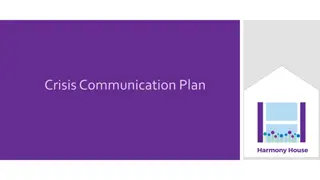Understanding Warm Lines: A Vital Support System Beyond Crisis Intervention
In the realm of mental health support, warm lines serve as invaluable resources beyond crisis intervention hotlines. Originating in the late 1950s, these lines cater to individuals facing non-crisis challenges such as depression, loneliness, and relationship issues. Project Return Peer Support Network stands out as a grassroots organization providing a friendly ear to those in need. Discover the distinctions between warm lines and hotlines, the daily workings of a warm line, and the essential role they play in mental health support services.
Download Presentation

Please find below an Image/Link to download the presentation.
The content on the website is provided AS IS for your information and personal use only. It may not be sold, licensed, or shared on other websites without obtaining consent from the author. Download presentation by click this link. If you encounter any issues during the download, it is possible that the publisher has removed the file from their server.
E N D
Presentation Transcript
A brief history According to the United States Library of Medicine, the first suicide hotline began assisting callers in Los Angeles in 1958 Within a decade, many other crisis intervention programs began to open throughout the country. By the early 2000 s, federal and local government funding began to be allocated to improve the services provided by suicide prevention programs. In 2001, SAMSHA established a network of suicide prevention call centers that have been known as Lifeline In October 2011, Lifeline took its 3 millionth call.
The need for non-crisis help So it has been established that there are plenty of numbers around the clock to assist callers who are suicidal. But what about callers who are not going through a crisis? And how about callers who are suffering from serious issues other than being actively suicidal?
These issues could include but are not limited to: Depression Paranoia/Psychotic Symptoms Loneliness Anxiety Relationship issues Homelessness
Project Return Peer Support Network Our organization has been around since the mid-1990 s. We began as a grassroots peer support organization through the vision of our founder Bill Compton. The warm line began with several volunteers who would answer cell phones from home. It was originally called the Friendship Line since our callers were considered our friends over the phone.
What are the differences between a Warm Line and a Hot Line? Hotlines are generally aimed at helping people through emergencies (crisis) such as suicidal ideation and domestic violence. The main goal of a hotline is to make sure that the caller is safe. Hotlines are not there for callers to talk about their issues or how their day is going A warm line will take those callers who just would like someone to have a conversation with.
What is an average day like at the warm line? On an average day, during the 5 hours that our line is open, we may take anywhere from 20 to 35 calls. Each caller is given one 20 minute call each night. At least half of our callers are regulars who call us every night or almost every night. We spend the last half hour debriefing meaning that we talk about our most difficult calls to give each other support and help process the events of the day.
The dos and donts of warm lines We do: let callers do all the talking if they need to We don t: cut off callers in order to talk about ourselves or own personal issues We do: provide supportive feedback and try to help callers cope with issues in their lives We don t: give advice of any kind (medical, legal or spiritual to name a few) We do: let our callers know that we understand what they are going through We don t: talk to callers in a judgmental way or nag them about their personal choices ( you should or you need to listen to me , etc) We do: remember that the caller s decisions are up to them and that we are just there to support them We don t: get frustrated when we see a caller making bad choices in his or her life (since their decisions are up to them and only them)
Warm Line Training We always tell new staff that the important components to success in our program is an ability to carry on friendly and uplifting conversations. However, there are some procedures that we use to train new staff. Some of the pieces to our training include worksheets and exercises to help improve listening and empathy skills. Before staff begins to interact with callers, we act out calls with them so that they have a chance to practice. We also are trained in suicide prevention as well.
Lived Life Experience Like many of the positions within the mental health field, lived life experience is a very important part of our job on the warm line. Most, if not all, of our staff have had some kind of lived-life challenge that they have overcame. These challenges often have to do with a mental health diagnosis but could also involve: alcohol/drug issues, childhood trauma and/or homelessness. Being able to talk about our lived-life challenges is a plus on the warm line because when we talk about how we have overcome these challenges, it gives our callers hope that they can overcome them as well.
Informational Referrals On the warm line, we also have a large array of different resources that we can share with our callers if needed. The most common resources that we share either have to do with support groups or housing. Since we are not case managers, we use a process called informational referrals What this means is that all we will do is give our caller phone numbers and the names of agencies and it is up to them to do the rest. Sometimes callers won t follow through and we remind ourselves that it is up to them to follow through whereas all we can do is provide support.
New Callers We are always excited to get new callers calling our line because that means that our program is growing. However, we have certain procedure that we need to follow when a new person calls our line. First, we will ask them how they got our number. Next, we have to go through a series of demographic questions which include their first name, age, city, and mental health diagnosis if they feel comfortable sharing. After that, we will quickly tell our new caller the rules of our line and what we do on our line.
Out of Area (OOA) Callers For our warm line, we are only contracted to serve callers within the Los Angeles County area. However, we often get calls from outside Los Angeles County. When we get these calls, we will give the caller a one-time, full-length call (otherwise known as a courtesy call ). At the end of this call, we will give the caller another number that they can use in the future. Sometimes, we are able to find a warm line for their specific region. If we can t find a support line for their region, we do have three lines that take calls from anywhere in the United States: The Metro Boston Line, The Massachusetts Edinberg Center Line and the Oregon Warm Line We keep the name and location of the OOA callers on file since if they call us after using up their courtesy call, we are not allowed to take their call at all.
Other calls we cant take Calls from people under 18 years old: we are not allowed to take their call but they can call the LA Teen Talk Line which is a similar program but for children under 18. (800-852-8336) People trying to locate missing family members: this is another situation that we are not equipped to deal with but we do have the LAPD Missing Persons Line number to refer people to (213-996-1800)
Documentation Just like with any other mental health or human services program, documentation is a tedious but important part of our jobs. For our call notes, we use an online database called Icarol For each call, we keep track of the start and end time and caller name. We also include a short description of what we talked about with that caller. In terms of billing, we use Community Outreach Services (COS) billing either as Community Client Services (231) or Mental Health Promotion (200) We do have a quota in terms of the number of calls we take, but on slow days if we can t take enough calls, we make up for it through doing outreach.
How could you start a warm line at your program? Since the Project Return warm line was one of the pioneering non- crisis lines, we have been active in helping other programs throughout the country to start similar lines. Often, a new warm line will start by having just one or two volunteers taking calls only a few hours a week. Some lines also are affiliated with peer training programs and have trainees and/or interns work on the warm line as part of their training. Often, a new warm line will begin by simply serving members of its home agency as an extension of the agency s services.
Outreach Community outreach is a must for any new warm line program to be able to both grow and sustain itself. There are several ways to go about doing outreach: email, telephone or through community events.
Email outreach The easiest and simplest way for any mental health program to conduct outreach is by sending out emails. Generally, this is done through sending a form letter with program flyers attached to it The contact information for various programs, agencies and community centers is easily available through online searches (Google, Bing, etc.) At our program, we use email outreach as a way to make up billing units when we don t have enough calls coming in. The only drawback of email outreach is that emails are often ignored or deleted and as a result of this, we don t hear back from many of the places that we have emailed.
Phone Outreach The second method of outreach that we use to promote our programs is telephone. This involves looking up the phone numbers of different programs online and cold-calling them randomly. To make it simple and easy, we try to follow a script which includes: Telling the recipient our name and where we are calling from Stating our reason for calling ( I have been reaching out to different community centers throughout LA to let them know about our program ) Attempting to set up an appointment to meet a program administrator face-to-face and exchange written materials such as flyers and brochures We always aim to meet program staff face-to-face because that is the most effective way to get the word out about our program.
Community Events Through my experiences, I have come to the conclusion that the most effective outreach method is making appearances at events in the community. These events are generally resource or health fairs. Before the event takes place, we check in to see whether we could have a table at the given event. Even at a modestly-attended event, we can easily reach out to at least 20 to 30 people whereas at a bigger event it could be much more than that. It is always helpful as well to build relations with other agencies and exchange information about future events.
Other forms of Outreach Appearing at community forums such as the monthly Service Area Advisory Committee (SAAC) meetings Word of mouth (letting friends, family and neighbors know about your program always helps) Passing out flyers at clinics, wellness centers or doctor s offices where you or a family member may be receiving services Making announcements at your local support group or 12-step meeting
Need for online support Over the last three decades, the internet has grown from something only accessible to a few select people to something that everyone has at their fingertips through their laptop, tablet or smart-phone. If someone is able to order a pizza, get a ride to the airport or find someone to walk their dog all through smartphone apps, why not have a way for them to access mental health services? Our online support group program at Project Return began in early 2015 as part of a program called Support and Advocacy for Growth and Employment (S.A.G.E.). The goal of our online support group program was to reach out and provide support to those who may not otherwise be able to attend a support group for a variety of different reasons.
How does someone access the Support Groups? The online groups are accessible through a website called Supportgroupscentral.com In order to gain access to our groups and all of the others, members must create a free account on the website simply by sharing their email address. Once people are signed on, they are able to view the menu of groups available by clicking on the Select Groups menu. Groups that are accessible include those facilitated by Project Return as well as a variety of other agencies including Depression And Bipolar Support Alliance, Association for Mental Health and Wellness, ARISE and Postpartum Support International. Once you have selected the program of your choice, then you can click on the program s logo and you will be given a full schedule of the groups for that particular program.
Finding a Group and Logging On To It Once you selected one or more groups to go to, all you have to do is sign up for it by clicking on the Register button. Once you have registered for the group, it will show up on your My Meetings page. You will be able to log on to the group beginning 15 minutes prior to the start of the group and as late as 30 minutes into the group (just in case you had another obligation and weren t able to get there at the beginning).
The Video/Audio Conference In order to access the group chat for the group, it is necessary to download the Zoom application on to whatever device you plan on using for the group. Once Zoom is installed, it will automatically open once you log on to your group. Once you have gotten on to your group, you are given the option of being on video or audio-only. (If you are using a computer, you will need to have a mic to get onto the audio and a webcam if you want to join the video conference). Either way, you will see the names of each of the other people on the group. There also is a text chat option available for people who are unable to access the audio or if you feel the need to send a private message to another group member (perhaps to share resources or information with them).
Other things you should know about the online groups Our online groups are a growing program. As of right now, we have six groups per week including groups every night of the week from 7 pm to 8 pm. We also have a second group on Monday that goes from 5:30 to 6:30. Our groups cover topics including coping, goal-setting and self-identity. As of the beginning of September, we will begin facilitating a Spanish group (titled Descubre la Fuerza Dentro de Ti) on Tuesday nights from 5 to 6. Each group has a maximum attendance of 25 members Usually at our groups, we have anywhere from 2 to 8 members. Unlike 12-step meetings, which don t allow cross-talking, we encourage members to jump in and share experiences, feedback and advice with each other. We want to create a welcoming, positive and supportive environment so that online group members feel encouraged to come back and make our online group community an important part of their support system.
